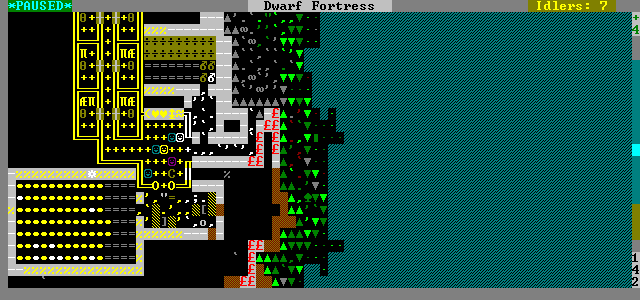

Wood is also a renewable source for charcoal, the fuel used in forges to make metal products in smelters or forges that are not magma-powered, and is needed to make steel even when you have magma forges. Trees are useful for the wood they provide, and wood is a basic building material, important for being the only material that beds can be made of, and, as metal bins and barrels require three times as much of less common metal resources as wood bins and barrels do, they are preferred materials for that, as well. Seen in the above image as "Trees: Sparse" and "Other Vegetation: Moderate". The list at the bottom of the biome information indicates the dominant soil/stone composition from top to bottom for the first eight layers. The selected biome will be highlighted with flashing Xs on the Local Map, and the biome's information will be displayed on the right side of the screen. Individual biomes, which form at least one map-tile of your embark location, can be cycled with the F#-keys for example, an area with 3 biomes present can be cycled using F1, F2 and F3. On the far right of the screen is a list of local features in the dominant biome. Remember that each tile on your embark screen is 48x48 tiles large. As such, smaller maps are recommended, especially for less powerful computers. The size of the embark location directly affects how much data about a map the game will have to store in your computer's memory, the size of your save files, and correspondingly, will dramatically affect the save and load times for your map, potentially make pathfinding more resource-intensive, and may generally slow your game down. Shift- u, m, k, and h will resize the embark location. The arrow keys control the X cursor in the center "Region" view while u, m, k, and h move the embark location around within the Local view. The world map cannot be directly controlled, and exists only to give you the overall view of where, relative to the rest of the features of the world, the region map is focused on. The local view constitutes a 16x16 grid of embark area tiles (each representing 48x48 tiles when you are playing the game) that is within a single region tile. A section of highlighted tiles in the Local view indicates the current embark location within the region. The Choose Fortress Location screen shows four separate sections, with three of them being three views of the land at three different levels of magnification: Local, Region, and World. Your home civilization will need more than one dwarven place on the map. There is just ONE BIG RULE: when your home civ is too small, you will first recognize after the 2nd winter that you won't get more immigrants, which can be extremely fun.


(Tracing down uniform conflicts isn't fun in a large-pop fortress.The process of choosing a site in v0.31 is much less involved than prior versions due to the ubiquitous presence of magma, gems, and ore, but that said there are still several considerations to keep in mind, namely aquifers, ore types, wood, climate, and neighbors. Just for simplicity if not for practicality. In general, it's best to not assign any dwarf in these roles to a military squad. Since military squads can also use picks, you might be able to do that as well? I think the Hunter "uniform" has a conflict with standard archer/crossbowdwarf Uniforms, though. You could, AFAIK, assign Woodcutters to a Military Squad that used Axes and they might still chop down trees. Conflicting Uniforms will remove that necessary tool. Miners, Hunters, and Woodcutters have a "Uniform" order that includes their weapon/tool that they use to fulfill that role. Yeah, it's an issue with conflicting Uniforms. Having miners/woodcutters/hunters in military squadsĮnabling more than one of mining/woodcutting/hunting on a single dwarf

Originally posted by kheftel:i know it's too late, but for next time, the things I know of that can cause problems with mining/woodcutting are:


 0 kommentar(er)
0 kommentar(er)
